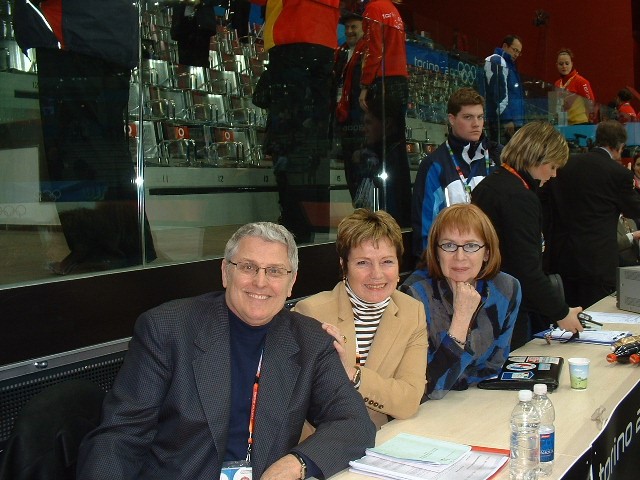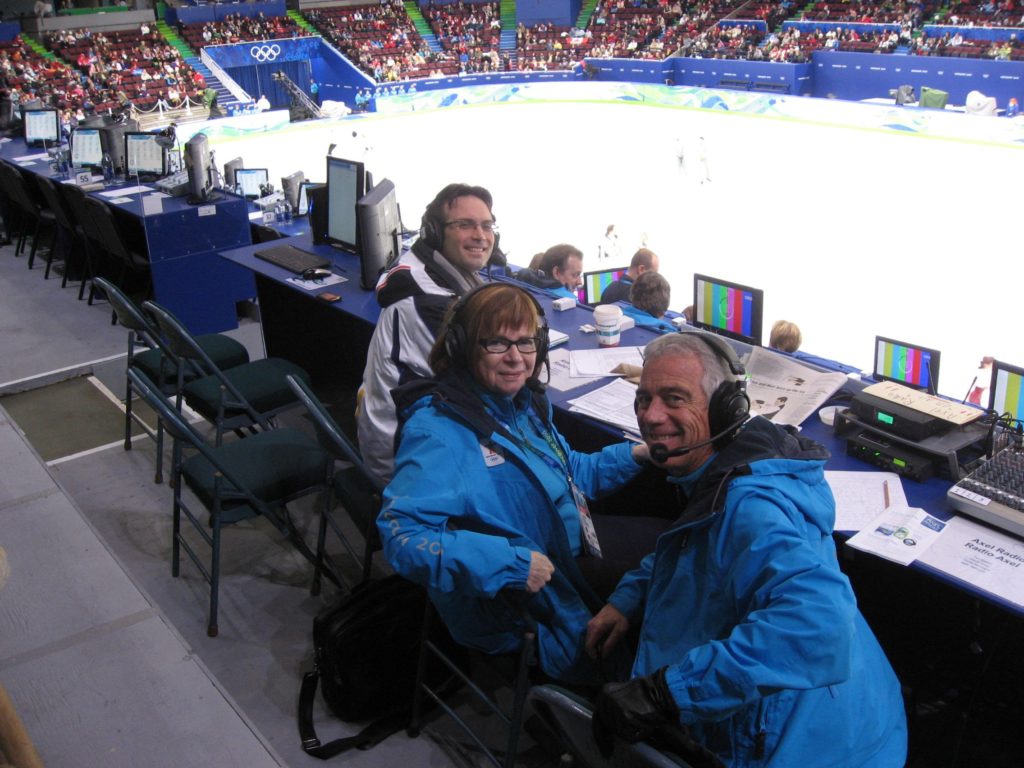
![]()
Skate Canada alumni and Hall of Fame member Sarah Kawahara walks the red carpet at this year’s 90th Oscar’s!
Our very own Sarah Kawahara choreographed the recent movie “I, Tonya” which was nominated for Best Supporting Actress, Best Actress and Best Film Editing. Allison Janney, a former figure skater who also played Tonya’s mother in the movie, won for Best Supporting Actress.
Sarah recounts her exciting interview on the red carpet.
“The red carpet was quite an experience!
The red carpet is very long and wide with 2/3 bordered by live audience and the last third the scenic Oscar wall. The E! escort wasn’t sure where to take me, so I got to walk towards the stairway to the theatre and actually see the whole layout of the carpet.
There were many stations of “Press” squeezed together with their cameras and TV hosts as they lined the length of the carpet. It had been raining the day before, so it was covered with a clear structure. Thankfully, the sun came out just in time for my interview.

There is no drinking water on the red carpet. I thought, ok I’ll change my shoes and lose my coat once I am there and hopefully there is bottled water… hmmm all the “Press” people brought their own water. Well, of course, I was a bit nervous and I felt like I had to clear my throat which almost never happens. Must be nerves… producer says we are on in “45, 30, just relax it’s just a 5 minute interview you can get through it”, countdown for me to gag on camera and not a drop of drinking water to be found… “in 5,4,3,2…”
Anyways, LIVE to tape, is really LIVE… period!”
![]()
Two weeks ago we featured some Olympic alumni memories from Megan Wing, Aaron Lowe and Sally Rehorick. This blog is Part 2 of Sally’s Olympic highlights and a recent recount of alumni Mike Slipchuk’s experience as Team Leader for our figure skating team at the recent 2018 Olympic Winter Games in Pyeongchang.
Sally Rehorick – Olympic Flames –Experiencing the sizzle, Coping with the heat[*] (PART 2)
 Salt Lake City 2002, Chef de Mission
Salt Lake City 2002, Chef de Mission
How does one get to be Chef de Mission for the Canadian Olympic Team? In my case, this was a competitive process: application, presentation to the selection committee, approvals through the COC. I was an elected member of the COC Board of Directors at the time.
As I mentioned at the start of this blog, a defining characteristic of these Games was the security aspect due to the events of September 11, 2001. This continued to be a concern for us through the whole Games. As part of our emergency planning, as the chief spokesperson for the team, I would need to know the whereabouts of every one of our 305 team members in the case of any security incident within thirty minutes of the incident. We set up a red-phone centre at Canada Olympic Lodge to use in case of emergencies. We briefed all athletes and other team members about what to do in case of an incident. Although there were a few situations that caused us concern, nothing major occurred. Kudos to the USA’s well-thought out and executed security plan.
What most figure skating people will remember is the scandal of the pairs event with the judging controversy that initially resulted in our pair Jamie Sale and David Pelletier coming second to the Russian pair, Berezhnaya and Sikarulidze. It was clear that the Canadians were the best. During the Games, it became apparent that there had been pressure exerted on some of the judges (although the French judge took the biggest hit) to place the Russians first. Without going into too much detail (this would take a full book!), I want to set the record straight concerning how the decision by the IOC to award a second gold medal to Sale and Pelletier came about within a week of the event.
The day after the free program, I spoke with the judges who had placed Sale and Pelletier first. They told me what had transpired in the post-event judges’ meeting when the French judge admitted that her federation had applied pressure to put the Russians first. I immediately telephoned Dick Pound of the IOC to alert him that this had happened and asked that the president of the IOC, Jacques Rogge, be brought into the conversation. I called a meeting of the COC’s emergency response team (of which I was a member) and suggested that a second gold medal be proposed. I pointed out that there had been a precedent for this in the case of Canadian synchronized swimmer, Sylvie Frechette, who had received a gold medal years after her Games at which there had also been a judging anomaly. Dick Pound moved quickly and after four days of intense work and negotiations, President Rogge announced that a second gold medal would be awarded to Jamie and David. A book needs to be written about all the ins and outs of what transpired through these days — it was not easy!
Although the pairs figure skating got the most publicity, for me, as Chef de Mission, it was the doping incident in the cross-country ski events that remain the most vivid situation of the whole Games. On the morning of the last day of the Games, just hours before the Closing Ceremony, I received a call from the team leader of our cross-country ski team. The news was breaking that the two Russian women who had placed first and second in the 30K event that day had tested positive for EPO (Erythropoietin), a performance enhancing drug used mainly for endurance competitions. Their medals in that event were confiscated. These were the same two athletes who had placed first and second in Canadian Beckie Scott’s sprint race during the first week of the Games. Beckie had won the bronze medal. If it could be proven that EPO was also in their system for the sprint race, then Beckie should receive the gold medal. To launch an appeal to the Court for Arbitration in Sport (CAS) would require a quick and detailed letter from the COC to the CAS. That required the rest of the day to organize, and I and our Chief Medical Officer (CMO) spent the entire Closing Ceremonies (sitting in the stands) composing the letter in order for it to reach the CAS offices before the Olympic flame went out. Any later would mean that the Games had officially ended and an appeal would have to go through a much lengthier process. These two photos show Beckie, Bob Foxford (the CMO) and me shortly before leaving for the Closing Ceremonies discussing this issue, and Beckie and me at the ceremony for her gold medal presentation two years after the Games.


CBC television followed me for a few weeks prior to the Games. Their interest was in my doing all the sports. Some of the video was shot during the Games. Here is the result: Peter Jordan’s It’s an Olympic Living.
Torino 2006, Officials Assessment Commission for Figure Skating
With the new International Judging System in place by 2004, a new method of assessing judges’ performance was implemented by the ISU. This Officials Assessment Commission (OAC) was appointed to examine the over 30,000 marks awarded during the Torino Olympic Winter Games. I have been a member of the OAC since its inception and have acted in this capacity in approximately thirty international competitions and championships. Here is a photo of three of the four members of the OAC at the Torino OWG in 2006: Joe Inman (USA) Sissy Krick (GER) and me.

Vancouver 2010, Member of the Organizing Committee for the Olympic Games (OCOG)/Beijing 2008, Head of VANOC observer delegation to Beijing Olympics
This was the first and only time I have been involved with the OCOG. While all my other Games roles have been as a volunteer, I was a member of the Senior Leadership Team for Vancouver 2010, a paid role, for nearly four years. For most of the time, I was the Director of International Client Services. My department handled all the planning and services for the Olympic Family (e.g. IOC members, Presidents and Secretaries General of International Sport Federations, and other dignitaries such as heads of state). As part of that role, I lead the Observer Mission to the Beijing Olympics 2008. Two hundred observers from Vancouver 2010 attended the Beijing Games to examine how their operations worked. Three months before the start of our Games, I was appointed Director of Official Languages for Translation Services. That role continued until the end of the Paralympics. But during the Olympics I had what was ultimately my favourite role of all: commentator for Axel Radio, an in-venue service for spectators at the figure skating venue. Lead by Ted Barton, our role was to give informed (and fun!) comments on everything from costumes to what to look for in the Tango Romantica! Spectators purchased earphones to listen in and used their cell phones to text questions to us. This photo shows our set-up (David Kirby, guest commentator Maurizio Margaglio, and Ted Barton just below us. Missing from the photo is the highly appreciated Jamie McGrigor (see New York Times article: On Radio, Experts Mix Fun with Games ).

[*] For a detailed version of this blog, please see the Powerpoint document under this link.
